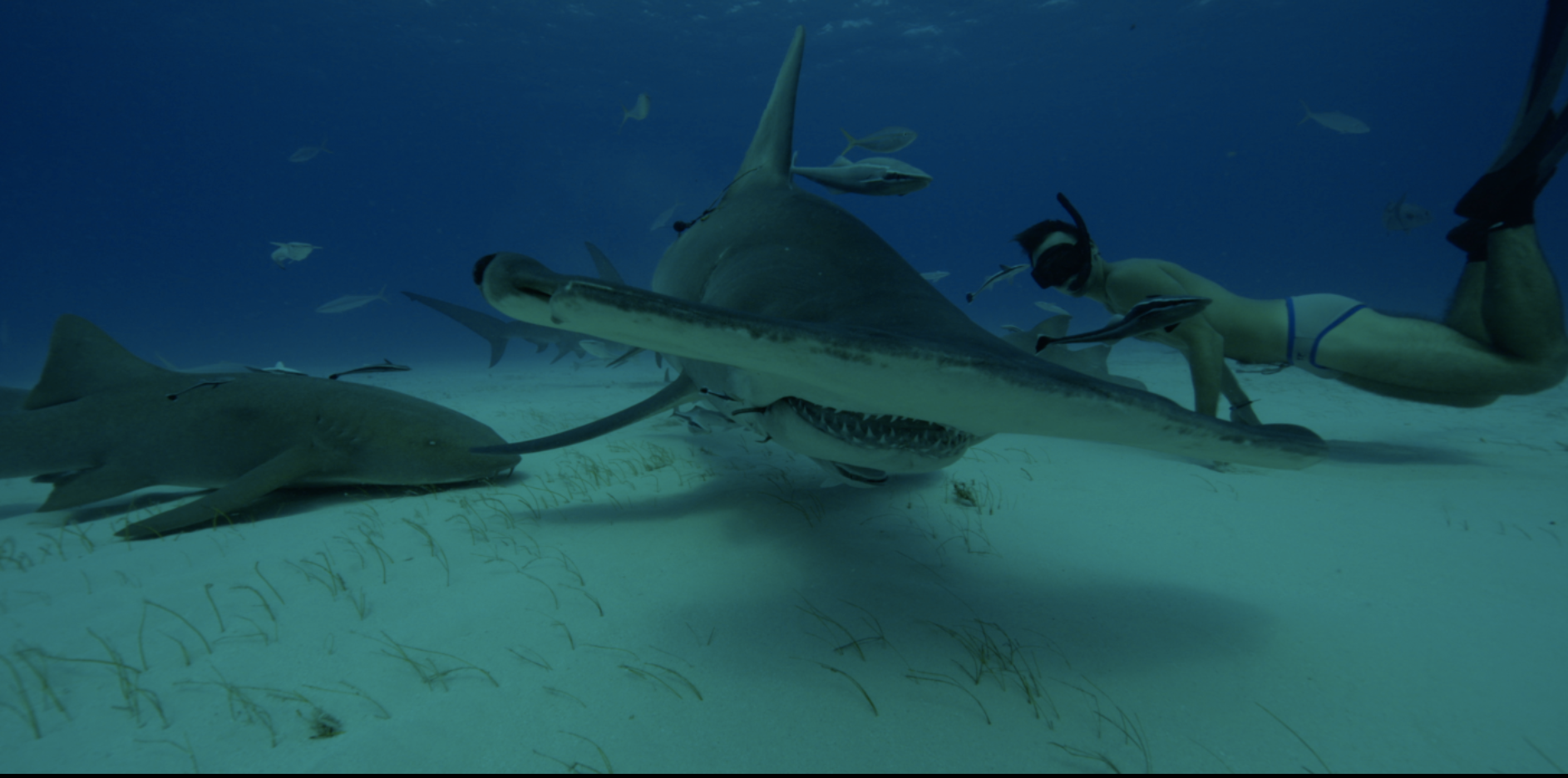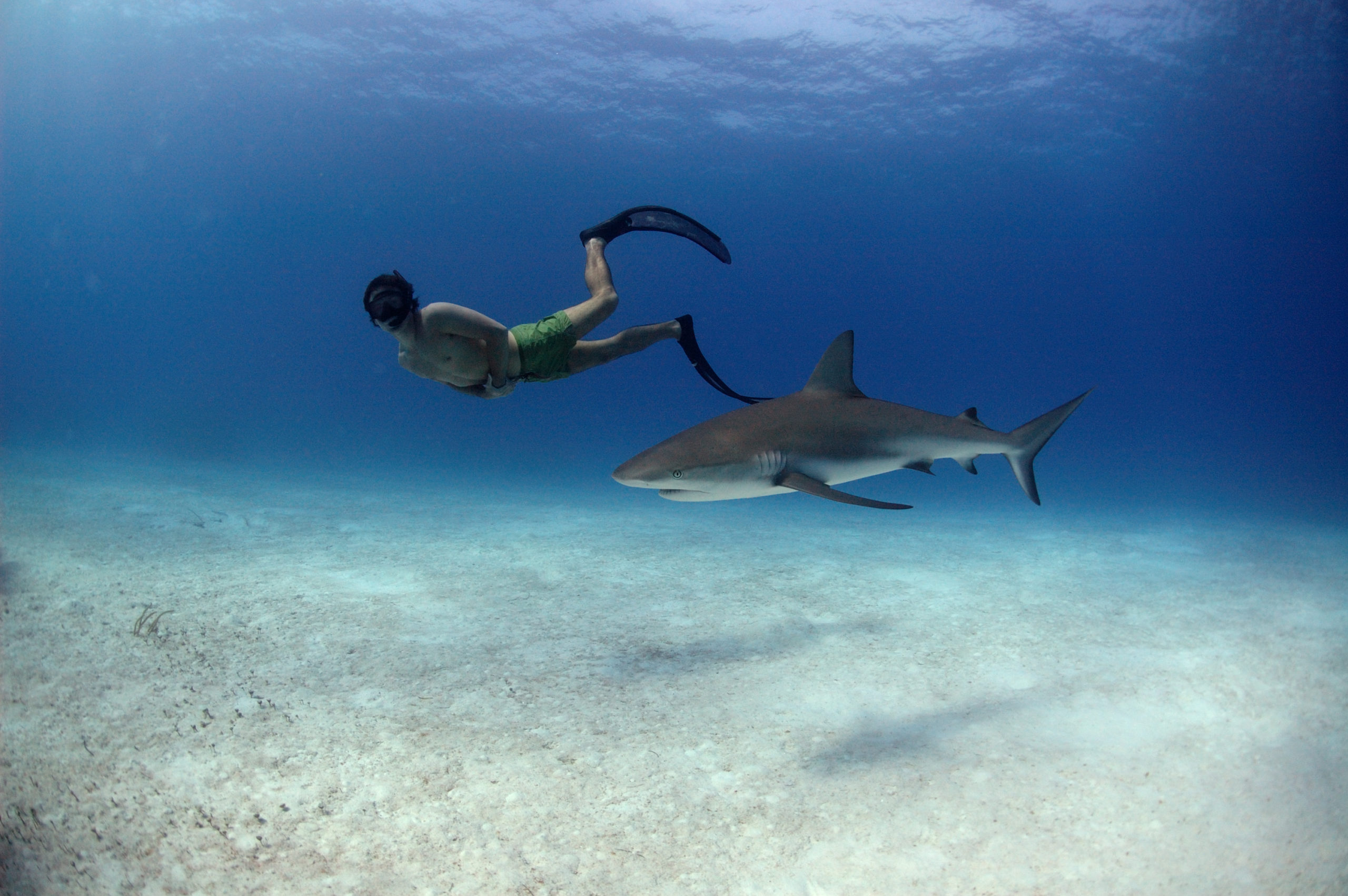As a new professor in Cinema Arts at the University of Windsor, Nick Hector is sharing his 30 years of experience with aspiring filmmakers. His experience has put him in the editing suite on films by many of Canada’s top filmmakers, including the late Allan King (Dying at Grace) and Sturla Gunnarsson: Air India 182 (2008), Force of Nature (2010), and Monsoon (2004). Films he has edited have screened at TIFF, Hot Docs and festivals around the world. Gunnarsson and Hector worked together again on Sharkwater Extinction, the final film from director Rob Stewart, who died tragically while filming the documentary in January 2017.
It is no surprise then that Hector, as deserving and humble as he is, would have been chosen to shape the 250 hours of footage, using the guidance of diary entries and audio recordings, in pursuit of structuring and completing the work that Stewart left behind.
POV editor Marc Glassman and POV contributor Michael John Long spoke with Hector at the POV office in late July, 2018, ahead of the film’s premiere at the Toronto International Film Festival. Sharkwater Extinction opens in theatres this week
This interview has been edited for brevity and clarity.
NH: Nick Hector
MG: Marc Glassman
MJL: Michael John Long
MJL: Nick, I am curious at what point you became involved with Sharkwater Extinction.
NH: I am into about a year-and-a-half of working on the film. I’ll give you the long spiel of how I became involved. Rob had been in contact with me in the December before his passing, and we were sort of feeling each other out. Rob had previously contacted me about Revolution. Our schedules didn’t work out at that time, but it was a fantastic meeting. Rob said, “You and I are going to start a revolution, right here, right now.” And I was always gutted that I couldn’t work on that film.
Then Rob passed, and it was obviously so tragic. A while later, Rob’s parents, acting as executive producers, approached a number of filmmakers, asking what they would do if they had Rob’s footage. The response was pretty universal; all shared how they would interpret the material, or the film they would make, or how they would express themselves. And when they came to me, my thought was that all we had to do was make Rob’s film. Rob was a great filmmaker; Rob was a prolific journalist. All we had to do was get access to every noodling that he did, get access to his diaries, and understand his message. Ultimately, Rob’s parents were looking for a creative team that was mature and experienced enough to not impose themselves on the film.
They opened their doors to me. It was so moving to be given Rob’s iPad notes, journal diaries, and emails. I found short essays about the art of the documentary and notes about what he was trying to accomplish. I found notes on music; notes on what he appreciated—or didn’t—about documentary filmmaking. An important note was in the form of an aspirational goal to make an underwater spy movie, which included a list of his favorite spy films and what he liked about their soundtracks. I came to realize that he wanted to make a personal, engaging film, with a traditional narrative; the idea being that documentary film was at its most powerful when engaging people, inspiring them, and not being a vehicle for just trading facts. Rob didn’t leave a blueprint or structure for the film, but he left something more valuable – a value system, a declaration of principles. This was so helpful because if there was a problem, we could react.
MG: How much footage did you have access to when Rob’s parents opened their doors?
NH: A part of the success of Sharkwater was that it was one of the first beautiful high definition films, so Rob was trying to do something similar by shooting in largely 6K and 8K formats. But it’s a little hard to calculate because he was also shooting in other formats because of joining forces with local teams, who had their own formats. I think we had about half a petabyte of data. Rob’s father, Brian, gave me this big trunk of hard drives, which could have been upwards of 250 hours of material.
MJL: Were there any entire locations that were left on the digital cutting room floor?
NH: Yes, there were a couple left in the hard drive trunk, but all but three made the film. It seemed clear that if Rob went somewhere and the story wasn’t happening, he planned on retuning. My understanding is that he was telling people, like any good filmmaker holding cards close to the chest, that he had shot three-quarters of this film. As I went through the material and his notes, it felt like he was even closer than that. The ratio of hours of footage was high, in part because he was so patient that he would be underwater filming for such a long time. If you recall, the scene of the Oceanic White Tips was only about a 1½ or 2-minute sequence, but Rob shot 8 or 9 hours worth of material.
MG: The Costa Rica scenes resemble something of a spy thriller. So, along with being able to shoot beautifully and whispering to sharks, did you also see Rob as an investigative journalist?
NH: My career started in broadcast journalism, and so it was interesting seeing Rob through that prism. He would do his research, plan meticulously, and still react to what was going on in the moment. He had a good nose for story, and wasn’t afraid to just park the planning and go where the story was.
MG: It seems to me that the thesis of the film was that, even with the international success of Sharkwater, that shark populations were declining. How were you able to get that idea across?
NH: We found the clearest iteration of Rob’s thesis in an interesting technique that he used during interviews, which he often shot by himself. His technique was to rough up the lights, get the camera in position, mic up the interviewee, and hit record. He would then have a conversation with the interviewee as he was returning to the lights and reframing his shot. The interviewee would almost always ask, ‘What is your film about?’ Rob would answer with his thesis clearly and calmly. The issue, however, was that from moving and adjusting, that particular audio isn’t very good.
I cobbled together enough pieces of audio recording to create a thesis statement for the film. At one point, I thought we could approach the narration like I Am Not Your Negro, and have an actor recite Rob’s written work overtop of his visuals, but there was a wealth of audio material because Rob did so much media over the course of his earlier films. We went through every media interview Rob ever did and were able to repurpose some of those recordings, the ideas of which were still relevant. He also had what he called “explainers,” which he would use to clarify what was going on with little audio notes. We could use these when we got into the editing room. And we were also gifted a recording for a Kickstarter campaign that Rob had completed in a hotel room, which sounded like it was recorded in a sound studio. The narration is a weave of those things.
MG: In terms of the narration, Michael and I both noticed a foreshadowing, in which Rob mentions the possibility of his passing throughout the film.
MJL: The concept of death comes up in the Costa Rica section and then again in the Los Angeles section, in which Rob mentions his own passing, and it all comes full circle in the “Last Dive” section.
MG: Was that a narrative arc used to structure the film and create a kind of drama throughout?
NH: Absolutely. Let me share how that arc-back technique came to be. I worked on the film alone from April of last year until December. I thought it was a good idea to bring in Sturla Gunnarsson, who is a friend and filmmaker I adore. I have had a lot of great professional relationships, and mine with Sturla, in the editing room, is a highlight of my career On Sharkwater Extinction, I was working in a vacuum and thought Sturla could be helpful because he has the experience and maturity to not try to make his own film. Not to my surprise, Sturla arrived and we went through his first stage of “stress testing” every decision I had made, to ask if that’s what Rob would have done, or where I came up with the idea.
Then we went into his second stage of questioning why I had structurally organized the film like I had. Sturla made two notable changes. The first was to move the section with the Oceanic White Tips earlier in the film because it allowed audiences to have an emotional connection with Rob and the sharks earlier, so that later, like in the Mark the Shark section [about a Miami fisherman who hunts sharks for sport], audiences will react differently. The second was that Sturla noticed that Rob was in the “fourth person singular” of making a conscious autobiography. A stroke of Sturla’s genius was the “retrospective voiceovers,” which we only included three or four times. They hinted where the film was going, but that tonally made the film pop. These voiceovers were not only fascinating but true to the experience of Rob’s media footprint. In interviews, from time to time, Rob talked about his passing. He would just drop it in the middle of an interview, saying “I know how I’m going to die and I know when I’m going to die,” and then just move on.
MG: Did you and Sturla feel the same about showing Rob as a character all the way through?
NH: Rob felt the same way. He felt that people need to engage in a character and have an emotional connection in order to care about the subject matter. He felt that people would care about sharks because he cared about sharks, and it would be even better if he could go as far as to anthropomorphize the sharks. But I think that it was a bit of a journey for Rob to get to that realization, from my readings of his diaries and notes. Although Sharkwater was a well-received film, he did get a little bit of criticism for putting so much of himself in it. In Revolution he pulled away from that. But then I think he came to realize that is what made Sharkwater work so well. It was clear through his journals and his explainers, that he was trying to show more of himself and his passion. Sturla and I tried to elevate that line, but Rob had established it.
When I worked with Allan King, in the last phase of his career, he had this expression that cinema verite film editing was like soapstone carving. It’s about pulling the pieces away and revealing the object within the stone. That’s what I think we did here: pull the pieces away and reveal the heart of the film, finding Rob. It was not a top down imposition of an intellectual idea. It was in the footage. That’s where the footage took us. And I will mention as an aside that I’m working on the “making of” and it’s just so hard because that’s what this film is inherently. I think the “making of” will be more of the collaborators’ experience.
MG: Did you and Sturla have a conversation about needing to shoot additional footage, based on the material you had to work with?
NH: There was an early iteration of the “Last Dive” section, which came from Rob filming in Mexico with a drone. It looked like a ghost ship, at twilight, going off toward the horizon without any lights. I cut a short sequence with that footage and added some voices talking about the tragedy on the radio. There was another iteration that used Getty Images, [but] it did not respect the language or the poetry of the film.
MG: Sturla, who we have also spoken to, mentioned that you knocked it out of the park.
NH: There is such great chemistry there. In the last scene of the film, Sturla had the music play out until the very end, as straight verité, with no dialogue, which built the tension and played against the expectation of waiting for someone to say something.
MG: Michael and I were both impressed with the use of the Hawaiian version of “Over the Rainbow” at the end credits and how well it worked.
NH: Sturla was certainly aware that it was Rob’s favorite song, and that he wanted it for the first Sharkwater. So, he made it his job for us to get that song for this film, and see Rob’s dream through.
MJL: Did you feel the pressure of working on a film that had such emotional demands?
NH: I certainly felt the pressure. When I took it on I knew that it was more than a film, but that people like Rob’s parents, who love him deeply, are heavily invested in seeing the film through. The stakes are rarely higher on a film. I felt confident that I had the passion and skill to get the job done. It was unbelievably hard though.
MG: Nick, there is a through line in your career of working on films about the environment, like Monsoon, Unfractured, and This Changes Everything. Is this subject matter personal to you?
NH: I have two daughters who are politically aware, and both want to become involved in political and environmental change. It is a subject that I am deeply passionate about. I am also fortunate to be able to choose the projects I am working on. If there’s something that I can do with my life’s work to help people like Rob or Sturla or Jennifer [Baichwal] get their message out, then that’s what I want to do with my time.
MJL: Do you have a favorite environmental documentary?
NH: I would say Manufactured Landscapes. It is just a masterpiece. Watermark, as well, is another of my favorites.
MG: Nick, you mentioned Allan King earlier. What sort of influence he has on your thought process and editing process?
NH: Allan’s impact on my work, and how I see the world, is enormous. I now teach in Cinema Arts at University of Windsor.Part of the reason for wanting to be a teacher is to take the wealth of knowledge given to me by Allan and Sturla and Jennifer, and to work with young people in the field. In the current mode of working, we often have remote assistants who are situated in Maine or Vancouver, but I want to able to hand that knowledge off in person.
One of the important lessons that Allan passed to me was the power of documentary film, which Rob understood so well. They understood that it is an emotional medium, and that emotional construction is more important than logical construction. If you can motivate and inspire people, instead of simply providing facts, that will affect change in the world.
MG: Allan always acknowledged that he was not just making films about subjects, but rather to satisfy and learn more about himself. Do you feel that was also true for Rob?
NH: That’s fascinating and very true. I worked with John Haslett Cuff on his film Actuality, which was written by Allan as a sort of autobiography. The challenge with Sharkwater Extinction was to finesse Rob’s work. He created the textural elements, which we simply added to as the bulk of our task. Jonathan Goldsmith’s score was a huge addition. There was a strong temp score and the film worked as a personal journey, as a suspense film, as an underwater spy film; but it really popped when Sturla added the post-factum reflections and Jonathan added his score.
I can’t help but come back to Allan, who I think of every day. Although his films were about micro events, which were reflections on society, he also felt that all good art was a Rorschach test, to provide the audience with a means of reflection. That’s certainly part of Rob’s work as well. On one level, there is the passion for his work, but there are more layers to his work in getting audiences to look at their lives and nature, and think deeply like Allan’s Rorschach.











